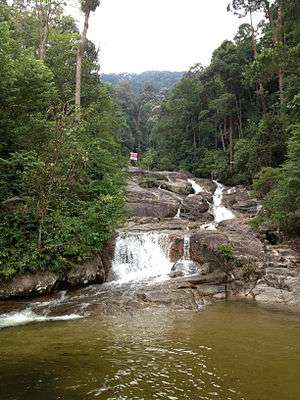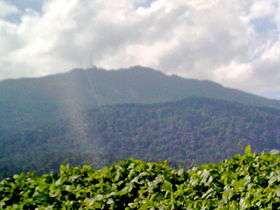Mount Ophir
Mount Ophir (Malay: Gunung Ledang) is a mountain in the Gunung Ledang National Park located in Tangkak District (formerly part of Muar), Johor, Malaysia. The summit is located between the border of Muar and Melaka. Standing at 1,276 m (4,186 ft),[1] it is the 64th highest mountain in Malaysia.
| Gunung Ledang | |
|---|---|
 Waterfall on Gunung Ledang | |
| Highest point | |
| Elevation | 1,276 m (4,186 ft) |
| Listing | Ribu |
| Geography | |
| Location | Tangkak, Johor, Malaysia |

Origins of its name
There are a few popular opinions regarding the origin of the mountain's name. According to one opinion, ancient history points to the mountain being the site of rich gold deposits, luring traders from as far as Greece and China. Ophir was a biblical-era land rich with natural resources mentioned in the Torah, also known at the Hebrew Bible.
In the 14th Century, the Chinese seafarers plying the Straits of Malacca called it Kim Sua meaning the 'golden mountain', possibly from the Hokkien or Taiwanese words: kim, or in characters 金 meaning gold and sua, or 山 meaning mountain .
Another source said that the Javanese during the period of the Majapahit empire named the mountain Gunong Ledang, which means 'lofty mountain', from Archaic Javanese word ledang meaning 'show-off'.[2]
It has been called "Ophir" by British cartographers since at least 1801, based on a map from that year. The name Ophir itself is thought to have originated from any of these languages:
- Hebrew, from אוֹפִיר transliterated to 'Owphiyr, or pronounced as ō·fēr, a Hebrew personal name and in reference to the biblical land of Ophir from which King Solomon obtained gold, precious gems and ivory for the Jewish Temple in Jerusalem.
Legend of Gunung Ledang
There is a popular Malay folklore which told of a princess with magical powers who resided on the mountain. She was wooed to be the wife of the then Sultan of Malacca, Sultan Mahmud Shah. However, she set seven impossible conditions for him as a means to reject his proposal.[1]
The conditions were:
- A bridge of gold for her to walk to Malacca from the mountain,
- A bridge of silver for her to return from Malacca to the mountain,
- Seven large clay jars of virgin's tears,
- Seven large clay jars of betel nut juice,
- Seven trays filled with hearts of fleas,
- Seven trays filled with hearts of mosquitoes, and
- A bowl of the blood of the Sultan's young son.
Some versions of the legend say that the Sultan was not able to fulfill any of these requests, while others say that he was able to fulfill the first six requests (thus causing the ruin of the Malacca Sultanate) but could not fulfill the final request which would have required him to kill his son.
Yet another version says that the Sultan approached his sons sleeping body and as he drew close with a dagger in hand the image of the Princess appeared before the Sultan and said to him that she could not possibly marry a man willing to wound his own son before vanishing, never to be seen again.
The point of the story is that the Sultan was either too proud or too blind to realise that the conditions were the Puteri's way of turning his proposal down.
Folklore has it that the gold and silver supposedly found on the mountain are attributed to; and a testament to this story. Hang Tuah and his companions were also learning their silat martial arts here on the top of this very mountain with a silat guru, Adiputera.
In poetry
A traditional Malay pantun makes the mountain proverbial:
Berapa tinggi pucuk pinang
Tinggi lagi asap api
Berapa tinggi Gunung Ledang
Tinggi lagi harapan hati.
However high is the trunk of the betel-nut tree,
Higher is the smoke of fire.
However high is Mount Ophir,
Higher are the hopes of the heart.
See also
References
- "Gunung Ledang". Tourism Malaysia. Archived from the original on 27 May 2014. Retrieved 25 May 2014.
- Kamus Dewan 4th Edition Retrieved 2013-09-27
External links
| Wikimedia Commons has media related to Mount Ophir. |